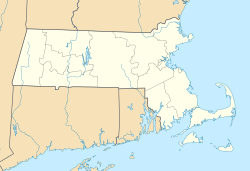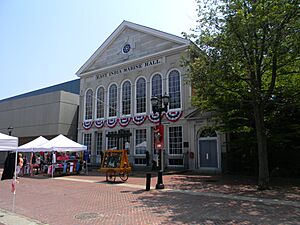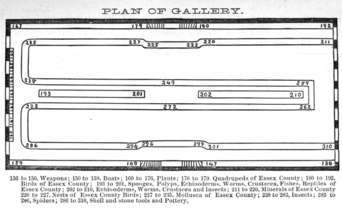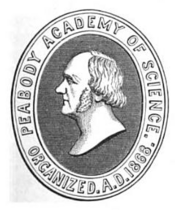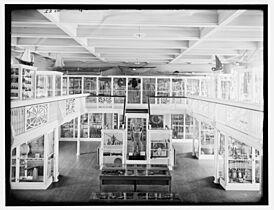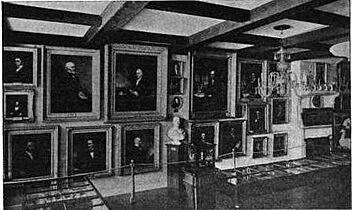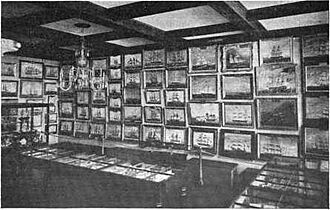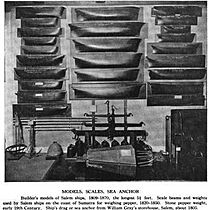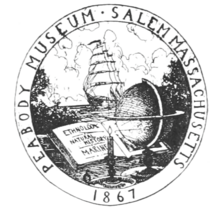Peabody Museum of Salem facts for kids
|
Peabody Museum of Salem
|
|
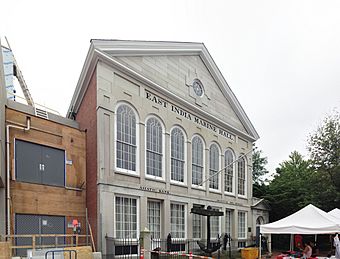
View of East India Marine Hall exterior, 2013
|
|
| Location | Essex St., Salem, Massachusetts |
|---|---|
| Area | 1 acre (0.40 ha) |
| Built | 1825 |
| NRHP reference No. | 66000783 |
Quick facts for kids Significant dates |
|
| Added to NRHP | October 15, 1966 |
| Designated NHL | December 21, 1965 |
The Peabody Museum of Salem was a famous museum in Salem, Massachusetts. It existed from 1915 to 1992. Before that, it was known as the Peabody Academy of Science from 1865 to 1915. This museum was partly a continuation of the East India Marine Society, which started in 1799. That society had a huge collection of items related to sea travel. These items were kept in a special building called the East India Marine Hall, built in 1825.
In 1992, the Peabody Museum joined with another group, the Essex Institute. Together, they formed the Peabody Essex Museum. The East India Marine Hall is now part of this larger, modern museum. This historic hall was named a National Historic Landmark in 1965. This honor recognized its long history. It represents the oldest museum collection in the United States that has been open continuously.
Contents
History of the Peabody Museum
How the Museum Started
The Peabody Academy of Science began in 1868. It was created to continue the work of the East India Marine Society. A kind man named George Peabody from London gave money to start it. His goal was to "promote science and useful knowledge" in the area of Essex County.
What the Museum Collected
The academy had a museum that showed many different things. It displayed animals, fossils, minerals, and plants. It also had "ethnological artifacts." These are items from different cultures, like weapons, costumes, tools, statues, and musical instruments. In 1915, the academy changed its name to the "Peabody Museum of Salem."
By 1949, the museum organized its collections into three main areas. These were ethnology (the study of cultures), maritime history (the history of sea travel), and natural history (the study of nature). The ethnology section included items from places like Hawaii, Japan, the Marquesas Islands, and New Zealand.
Where the Collections Were Displayed
The museum showed its collections in the East India Marine Hall. In 1953, new areas called the Crowninshield Galleries were added to expand the display space. Important people like Ernest Stanley Dodge and Walter Muir Whitehill worked at the museum.
Later Mergers
In 1984, the China Trade Museum from Milton, Massachusetts, joined with the Peabody Museum. Then, in 1992, the Peabody Museum merged with the Essex Institute. This big merger created the Peabody Essex Museum, which is still open today.
East India Marine Hall: A Historic Building
Building the Hall
The East India Marine Hall was built between 1824 and 1825. It was made for the East India Marine Society. They needed a place to keep and show their large collection of items. A person named Thomas Waldron Sumner is thought to have designed the building.
The hall is located on the south side of Essex Street. Today, it is part of the larger Peabody Essex Museum. When it was first built, it was a two-story building. The front, facing Essex Street, was made of granite. The sides were made of brick. It was about 45 feet wide and 100 feet long. The front of the building has been kept. It has six rectangular openings on the first floor. The second floor has seven tall, round-arched windows. The triangular part at the top, called a pediment, has a round window in its center.
Changes Over Time
The inside of the building has been changed many times over the years. Because of these changes, much of the original design has been lost. The first floor was originally used for shops. But from 1867 to 1869, it was changed into a museum space. This happened after the Peabody Academy of Science bought the building. During this change, the main entrances on the front were closed. New entrances were added on the east and west sides. The first floor is now fully connected to the newer parts of the Peabody Essex Museum, which were built in the 2000s.
The upper floor of the hall was designed as a large room for dances and events. It has always been used as a big open gallery for displays. However, many of its original features were lost during the changes in the 1860s.
A National Landmark
The East India Marine Hall was named a National Historic Landmark in 1965. It was also listed on the National Register of Historic Places in 1966. This was because it is one of the oldest museum spaces in the United States that has been used continuously.
See also
- American Neptune, a journal published by the museum
- List of National Historic Landmarks in Massachusetts
- National Register of Historic Places listings in Salem, Massachusetts
Images for kids


